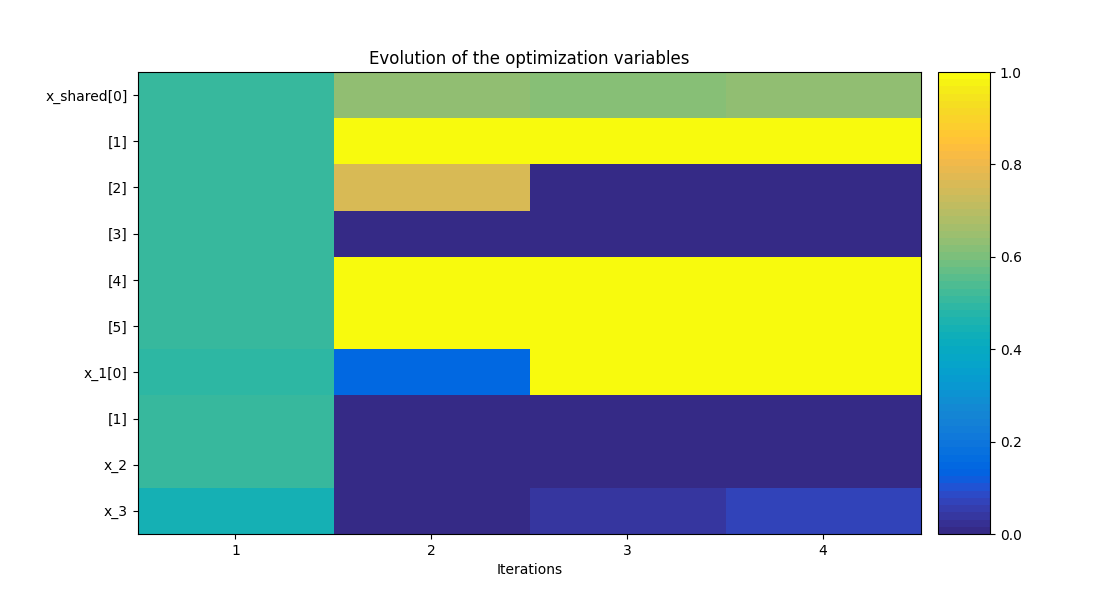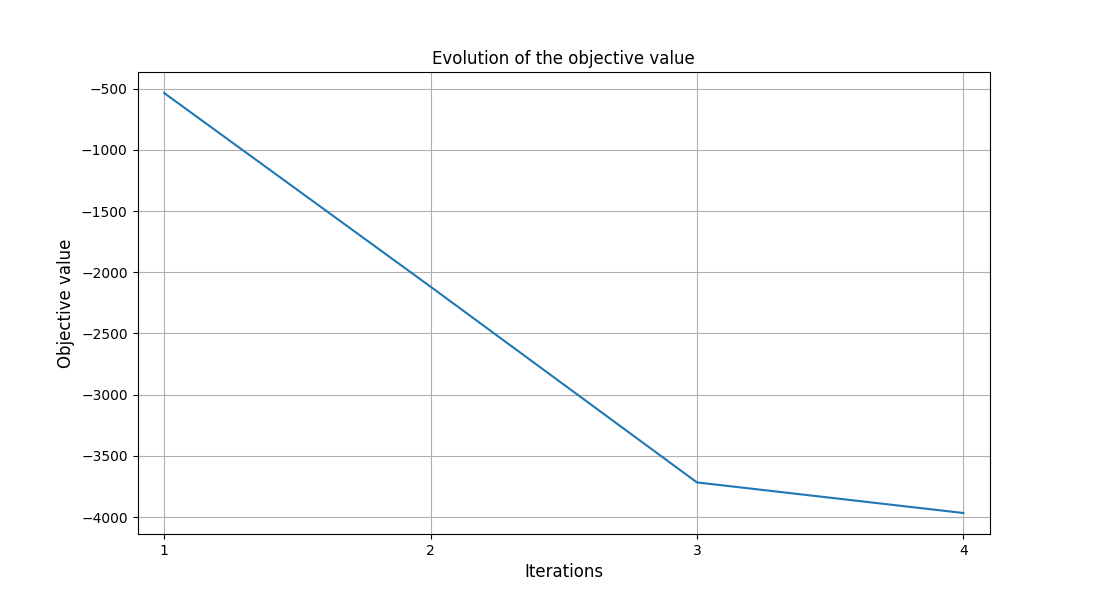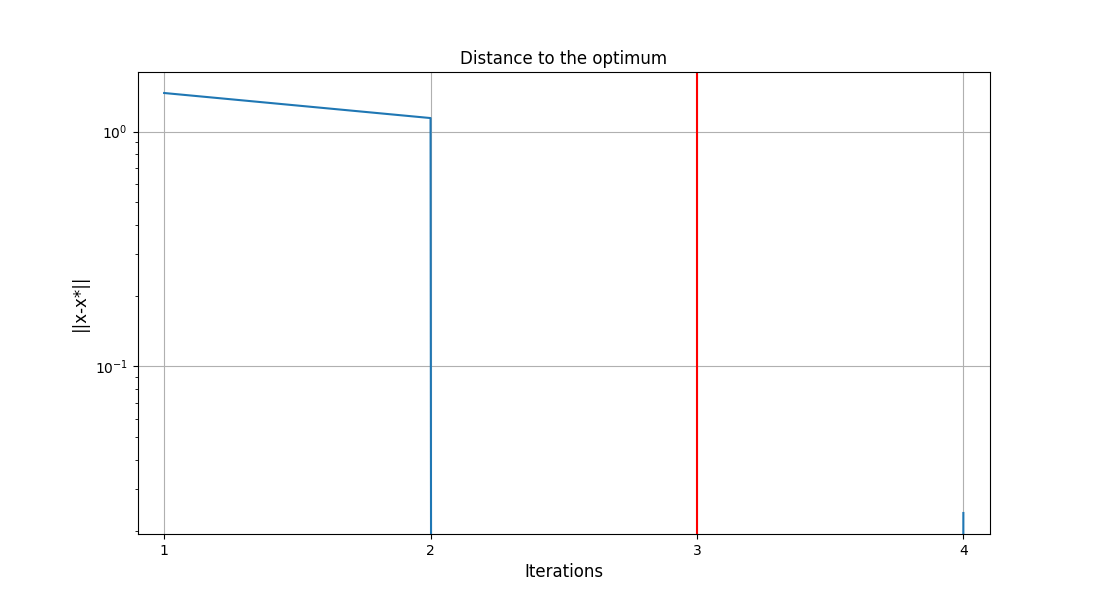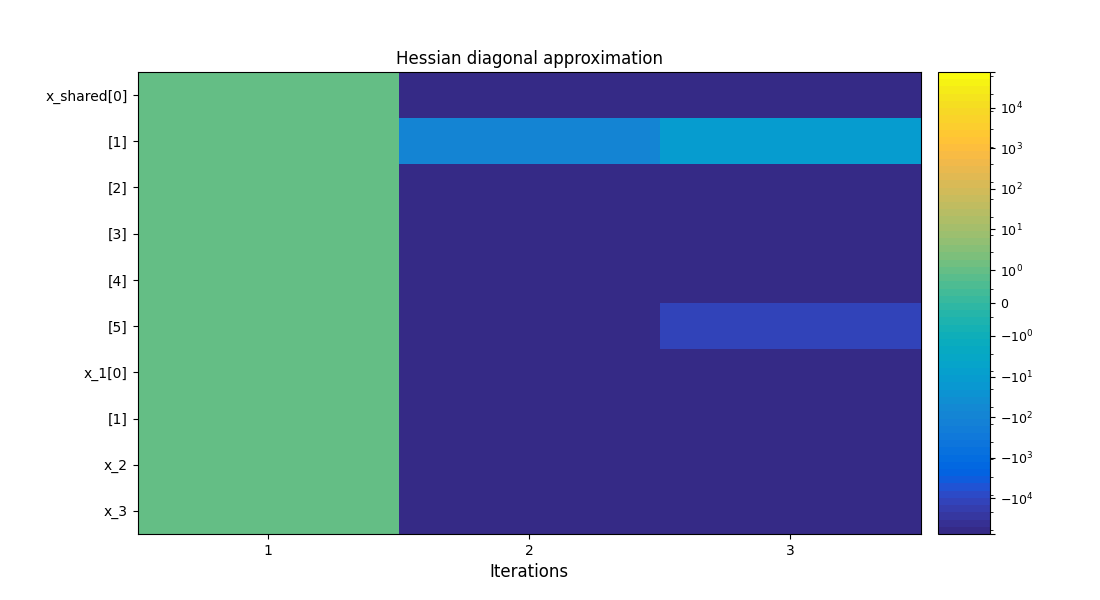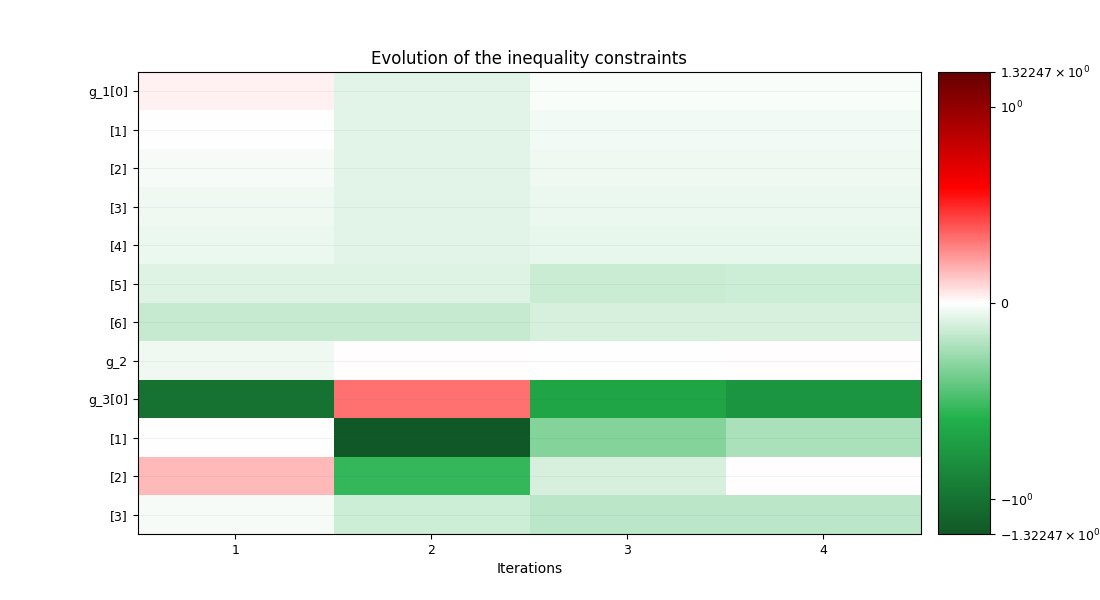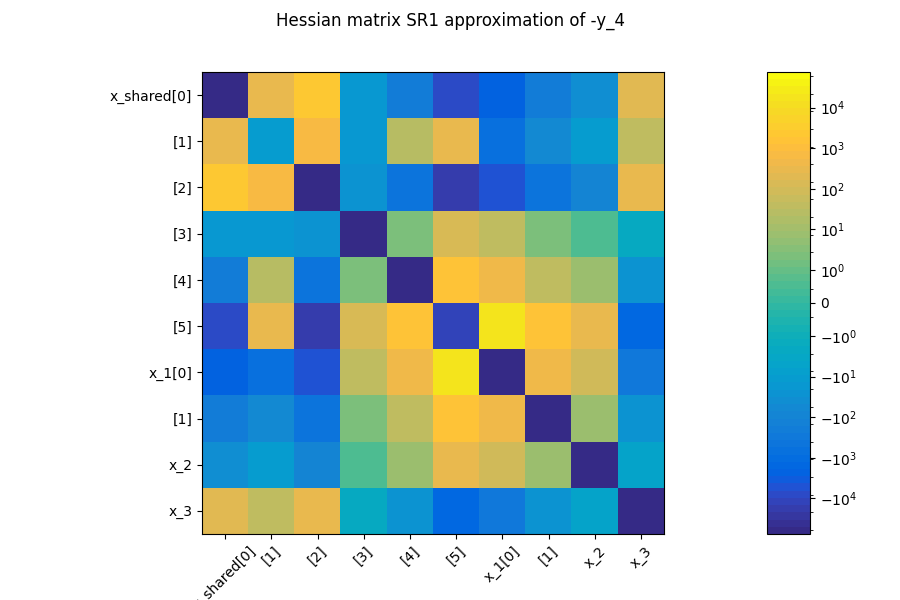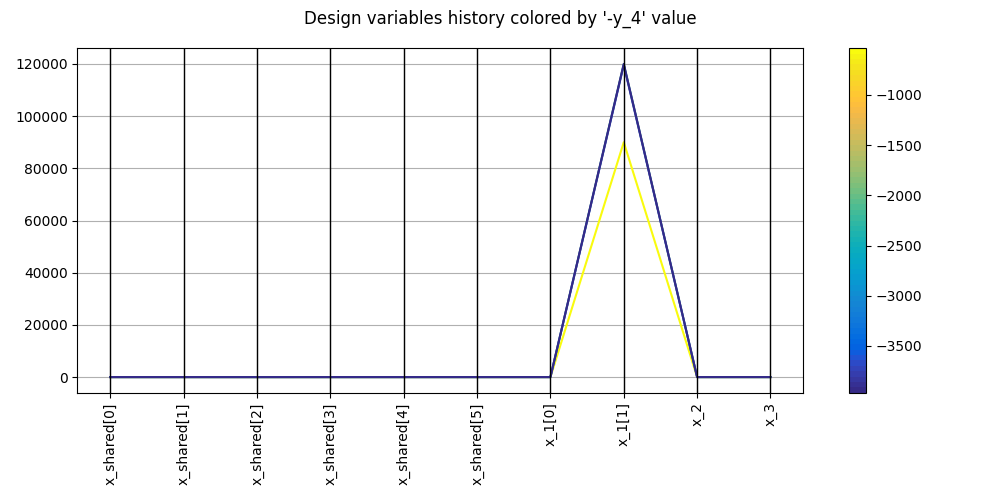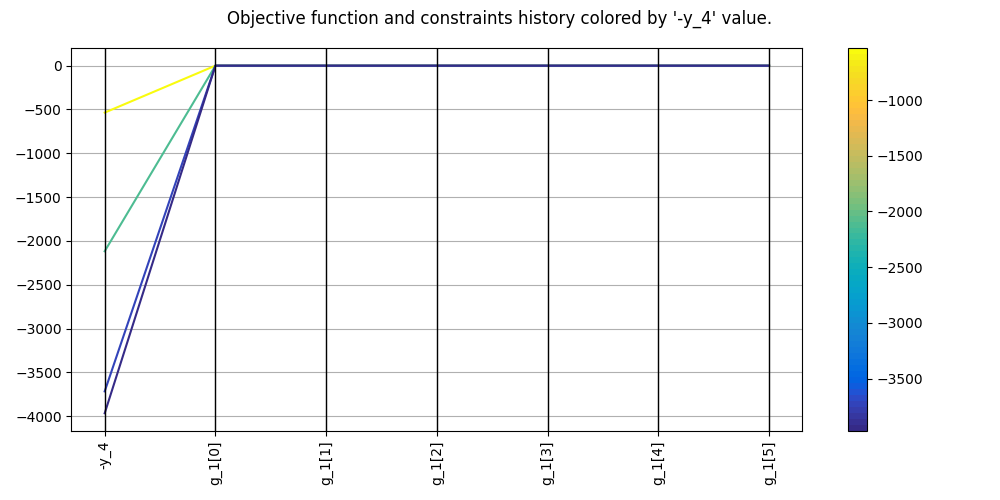Note
Go to the end to download the full example code
MDF-based MDO on the Sobieski SSBJ test case¶
from __future__ import annotations
from gemseo import configure_logger
from gemseo import create_discipline
from gemseo import create_scenario
from gemseo import generate_n2_plot
from gemseo.problems.sobieski.core.design_space import SobieskiDesignSpace
configure_logger()
<RootLogger root (INFO)>
Instantiate the disciplines¶
First, we instantiate the four disciplines of the use case:
SobieskiPropulsion,
SobieskiAerodynamics,
SobieskiMission
and SobieskiStructure.
disciplines = create_discipline([
"SobieskiPropulsion",
"SobieskiAerodynamics",
"SobieskiMission",
"SobieskiStructure",
])
We can quickly access the most relevant information of any discipline (name, inputs,
and outputs) with Python’s print() function. Moreover, we can get the default
input values of a discipline with the attribute MDODiscipline.default_inputs
for discipline in disciplines:
print(discipline)
print(f"Default inputs: {discipline.default_inputs}")
SobieskiPropulsion
Default inputs: {'x_shared': array([5.0e-02, 4.5e+04, 1.6e+00, 5.5e+00, 5.5e+01, 1.0e+03]), 'x_3': array([0.5]), 'y_23': array([12562.01206488]), 'c_3': array([4360.])}
SobieskiAerodynamics
Default inputs: {'c_4': array([0.01375]), 'y_12': array([5.06069742e+04, 9.50000000e-01]), 'x_shared': array([5.0e-02, 4.5e+04, 1.6e+00, 5.5e+00, 5.5e+01, 1.0e+03]), 'x_2': array([1.]), 'y_32': array([0.50279625])}
SobieskiMission
Default inputs: {'y_24': array([4.15006276]), 'y_34': array([1.10754577]), 'x_shared': array([5.0e-02, 4.5e+04, 1.6e+00, 5.5e+00, 5.5e+01, 1.0e+03]), 'y_14': array([50606.9741711 , 7306.20262124])}
SobieskiStructure
Default inputs: {'c_0': array([2000.]), 'y_21': array([50606.9741711]), 'x_1': array([0.25, 1. ]), 'x_shared': array([5.0e-02, 4.5e+04, 1.6e+00, 5.5e+00, 5.5e+01, 1.0e+03]), 'y_31': array([6354.32430691]), 'c_2': array([6.]), 'c_1': array([25000.])}
You may also be interested in plotting the couplings of your disciplines.
A quick way of getting this information is the high-level function
generate_n2_plot(). A much more detailed explanation of coupling
visualization is available here.
generate_n2_plot(disciplines, save=False, show=True)
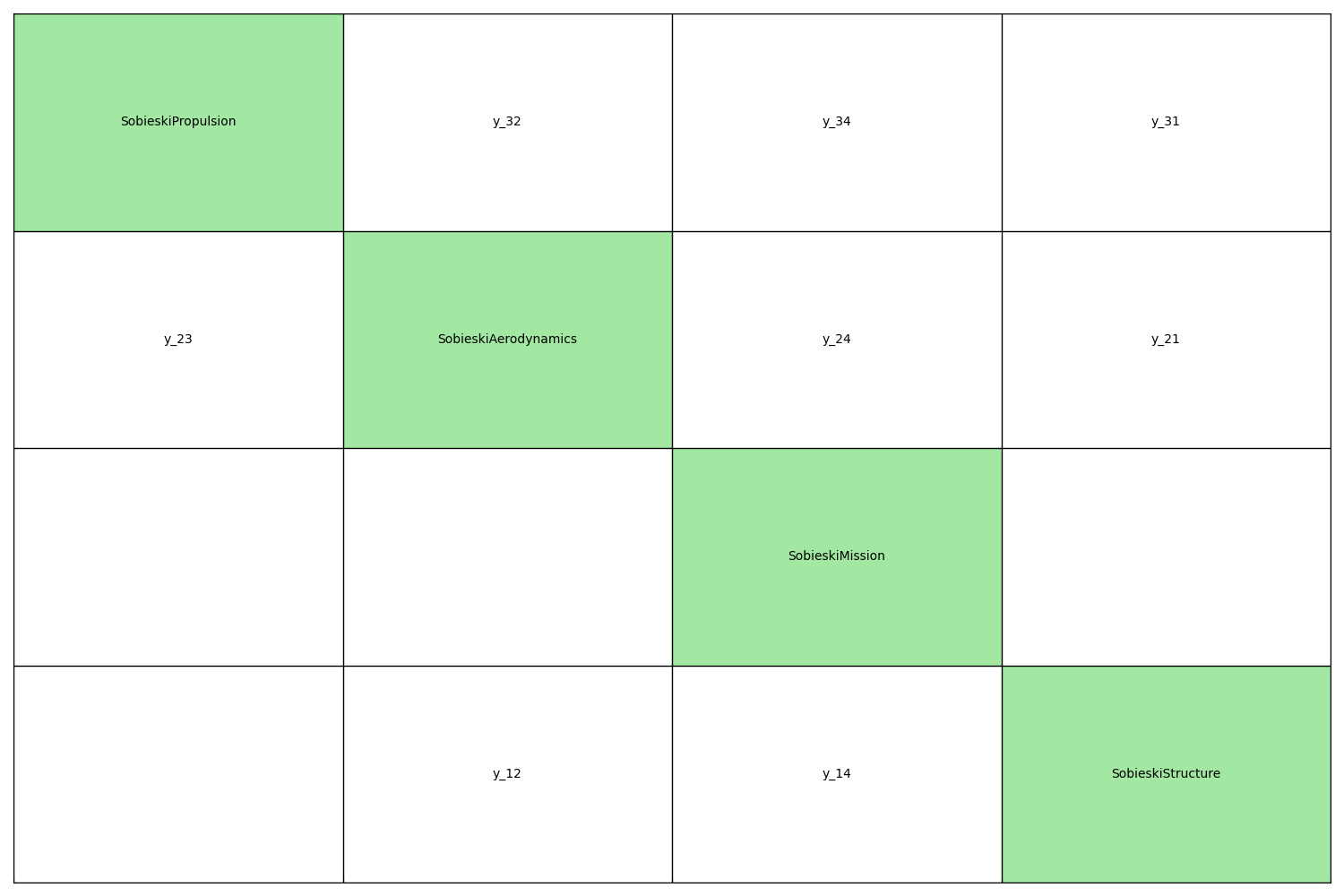
Build, execute and post-process the scenario¶
Then, we build the scenario which links the disciplines
with the formulation and the optimization algorithm. Here, we use the
MDF formulation. We tell the scenario to minimize -y_4 instead of
minimizing y_4 (range), which is the default option.
Instantiate the scenario¶
During the instantiation of the scenario, we provide some options for the MDF formulations:
formulation_options = {
"tolerance": 1e-14,
"max_mda_iter": 50,
"warm_start": True,
"use_lu_fact": False,
"linear_solver_tolerance": 1e-14,
}
'warm_start: warm starts MDA,'warm_start: optimize the adjoints resolution by storing the Jacobian matrix LU factorization for the multiple RHS (objective + constraints). This saves CPU time if you can pay for the memory and have the full Jacobians available, not just matrix vector products.'linear_solver_tolerance': set the linear solver tolerance, idem we need full convergence
design_space = SobieskiDesignSpace()
design_space
scenario = create_scenario(
disciplines,
"MDF",
"y_4",
design_space,
maximize_objective=True,
**formulation_options,
)
Set the design constraints¶
for c_name in ["g_1", "g_2", "g_3"]:
scenario.add_constraint(c_name, constraint_type="ineq")
XDSMIZE the scenario¶
Generate the XDSM file on the fly:
log_workflow_status=Truewill log the status of the workflow in the console,save_html(defaultTrue) will generate a self-contained HTML file, that can be automatically opened usingshow_html=True.
scenario.xdsmize(save_html=False)
Define the algorithm inputs¶
We set the maximum number of iterations, the optimizer
and the optimizer options. Algorithm specific options are passed there.
Use the high-level function get_algorithm_options_schema()
for more information or read the documentation.
Here ftol_rel option is a stop criteria based on the relative difference in the objective between two iterates ineq_tolerance the tolerance determination of the optimum; this is specific to the GEMSEO wrapping and not in the solver.
algo_options = {
"ftol_rel": 1e-10,
"ineq_tolerance": 2e-3,
"normalize_design_space": True,
}
scn_inputs = {"max_iter": 15, "algo": "SLSQP", "algo_options": algo_options}
See also
We can also generate a backup file for the optimization,
as well as plots on the fly of the optimization history if option
generate_opt_plot is True.
This slows down a lot the process, here since SSBJ is very light
scenario.set_optimization_history_backup(file_path="mdf_backup.h5",
each_new_iter=True,
each_store=False, erase=True,
pre_load=False,
generate_opt_plot=True)
Execute the scenario¶
scenario.execute(scn_inputs)
INFO - 13:54:39:
INFO - 13:54:39: *** Start MDOScenario execution ***
INFO - 13:54:39: MDOScenario
INFO - 13:54:39: Disciplines: SobieskiAerodynamics SobieskiMission SobieskiPropulsion SobieskiStructure
INFO - 13:54:39: MDO formulation: MDF
INFO - 13:54:39: Optimization problem:
INFO - 13:54:39: minimize -y_4(x_shared, x_1, x_2, x_3)
INFO - 13:54:39: with respect to x_1, x_2, x_3, x_shared
INFO - 13:54:39: subject to constraints:
INFO - 13:54:39: g_1(x_shared, x_1, x_2, x_3) <= 0.0
INFO - 13:54:39: g_2(x_shared, x_1, x_2, x_3) <= 0.0
INFO - 13:54:39: g_3(x_shared, x_1, x_2, x_3) <= 0.0
INFO - 13:54:39: over the design space:
INFO - 13:54:39: +-------------+-------------+-------+-------------+-------+
INFO - 13:54:39: | Name | Lower bound | Value | Upper bound | Type |
INFO - 13:54:39: +-------------+-------------+-------+-------------+-------+
INFO - 13:54:39: | x_shared[0] | 0.01 | 0.05 | 0.09 | float |
INFO - 13:54:39: | x_shared[1] | 30000 | 45000 | 60000 | float |
INFO - 13:54:39: | x_shared[2] | 1.4 | 1.6 | 1.8 | float |
INFO - 13:54:39: | x_shared[3] | 2.5 | 5.5 | 8.5 | float |
INFO - 13:54:39: | x_shared[4] | 40 | 55 | 70 | float |
INFO - 13:54:39: | x_shared[5] | 500 | 1000 | 1500 | float |
INFO - 13:54:39: | x_1[0] | 0.1 | 0.25 | 0.4 | float |
INFO - 13:54:39: | x_1[1] | 0.75 | 1 | 1.25 | float |
INFO - 13:54:39: | x_2 | 0.75 | 1 | 1.25 | float |
INFO - 13:54:39: | x_3 | 0.1 | 0.5 | 1 | float |
INFO - 13:54:39: +-------------+-------------+-------+-------------+-------+
INFO - 13:54:39: Solving optimization problem with algorithm SLSQP:
INFO - 13:54:39: 7%|▋ | 1/15 [00:00<00:01, 8.83 it/sec, obj=-536]
INFO - 13:54:39: 13%|█▎ | 2/15 [00:00<00:02, 6.44 it/sec, obj=-2.12e+3]
INFO - 13:54:40: 20%|██ | 3/15 [00:00<00:02, 5.22 it/sec, obj=-3.72e+3]
INFO - 13:54:40: 27%|██▋ | 4/15 [00:00<00:02, 5.23 it/sec, obj=-3.97e+3]
INFO - 13:54:40: Optimization result:
INFO - 13:54:40: Optimizer info:
INFO - 13:54:40: Status: 8
INFO - 13:54:40: Message: Positive directional derivative for linesearch
INFO - 13:54:40: Number of calls to the objective function by the optimizer: 5
INFO - 13:54:40: Solution:
INFO - 13:54:40: The solution is feasible.
INFO - 13:54:40: Objective: -3716.555963095829
INFO - 13:54:40: Standardized constraints:
INFO - 13:54:40: g_1 = [-0.01608807 -0.03194613 -0.04316738 -0.05095364 -0.05658344 -0.1380806
INFO - 13:54:40: -0.1019194 ]
INFO - 13:54:40: g_2 = -0.0005956359157315294
INFO - 13:54:40: g_3 = [-0.67076432 -0.32923568 -0.10429595 -0.183255 ]
INFO - 13:54:40: Design space:
INFO - 13:54:40: +-------------+-------------+---------------------+-------------+-------+
INFO - 13:54:40: | Name | Lower bound | Value | Upper bound | Type |
INFO - 13:54:40: +-------------+-------------+---------------------+-------------+-------+
INFO - 13:54:40: | x_shared[0] | 0.01 | 0.05985109102106711 | 0.09 | float |
INFO - 13:54:40: | x_shared[1] | 30000 | 59785.5639131558 | 60000 | float |
INFO - 13:54:40: | x_shared[2] | 1.4 | 1.4 | 1.8 | float |
INFO - 13:54:40: | x_shared[3] | 2.5 | 2.540129655171779 | 8.5 | float |
INFO - 13:54:40: | x_shared[4] | 40 | 69.80684214977607 | 70 | float |
INFO - 13:54:40: | x_shared[5] | 500 | 1493.746505655324 | 1500 | float |
INFO - 13:54:40: | x_1[0] | 0.1 | 0.4 | 0.4 | float |
INFO - 13:54:40: | x_1[1] | 0.75 | 0.7530970468499044 | 1.25 | float |
INFO - 13:54:40: | x_2 | 0.75 | 0.7530625218813826 | 1.25 | float |
INFO - 13:54:40: | x_3 | 0.1 | 0.1411034879427379 | 1 | float |
INFO - 13:54:40: +-------------+-------------+---------------------+-------------+-------+
INFO - 13:54:40: *** End MDOScenario execution (time: 0:00:00.888213) ***
{'max_iter': 15, 'algo_options': {'ftol_rel': 1e-10, 'ineq_tolerance': 0.002, 'normalize_design_space': True}, 'algo': 'SLSQP'}
Save the optimization history¶
We can save the whole optimization problem and its history for further post processing:
scenario.save_optimization_history("mdf_history.h5", file_format="hdf5")
INFO - 13:54:40: Exporting the optimization problem to the file mdf_history.h5 at node
We can also save only calls to functions and design variables history:
scenario.save_optimization_history("mdf_history.xml", file_format="ggobi")
Print optimization metrics¶
scenario.print_execution_metrics()
INFO - 13:54:40: Scenario Execution Statistics
INFO - 13:54:40: Discipline: SobieskiPropulsion
INFO - 13:54:40: Executions number: 67
INFO - 13:54:40: Execution time: 0.027332746991305612 s
INFO - 13:54:40: Linearizations number: 4
INFO - 13:54:40: Discipline: SobieskiAerodynamics
INFO - 13:54:40: Executions number: 76
INFO - 13:54:40: Execution time: 0.037378673936473206 s
INFO - 13:54:40: Linearizations number: 4
INFO - 13:54:40: Discipline: SobieskiMission
INFO - 13:54:40: Executions number: 4
INFO - 13:54:40: Execution time: 0.000320738967275247 s
INFO - 13:54:40: Linearizations number: 4
INFO - 13:54:40: Discipline: SobieskiStructure
INFO - 13:54:40: Executions number: 75
INFO - 13:54:40: Execution time: 0.19339522297377698 s
INFO - 13:54:40: Linearizations number: 4
INFO - 13:54:40: Total number of executions calls: 222
INFO - 13:54:40: Total number of linearizations: 16
Post-process the results¶
Plot the optimization history view¶
scenario.post_process("OptHistoryView", save=False, show=True)
<gemseo.post.opt_history_view.OptHistoryView object at 0x7f2d17ca59d0>
Plot the basic history view¶
scenario.post_process(
"BasicHistory", variable_names=["x_shared"], save=False, show=True
)
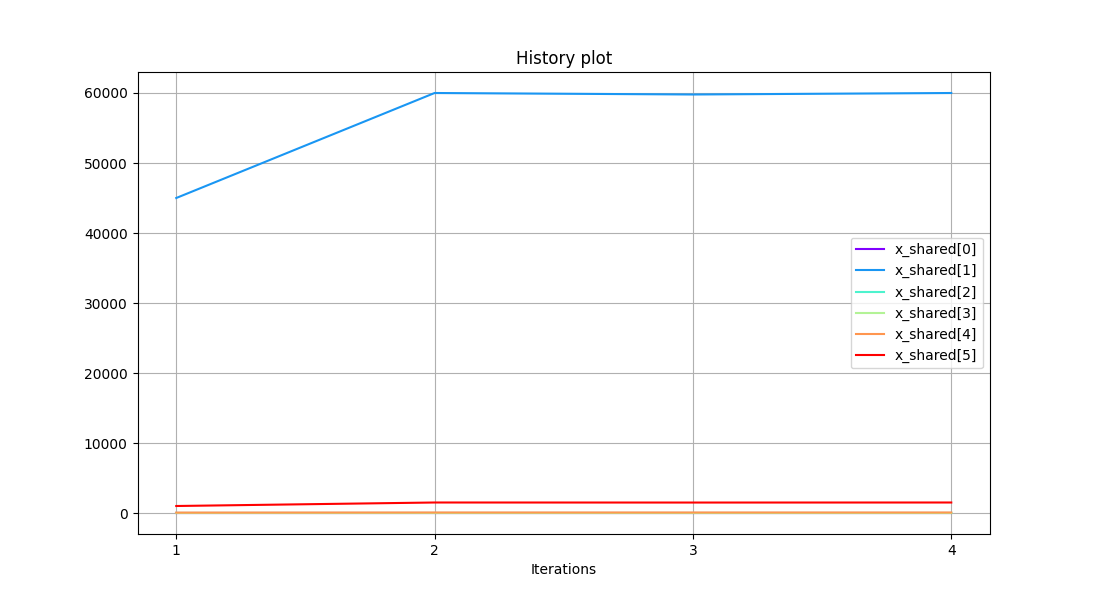
<gemseo.post.basic_history.BasicHistory object at 0x7f2d153b5670>
Plot the constraints and objective history¶
scenario.post_process("ObjConstrHist", save=False, show=True)
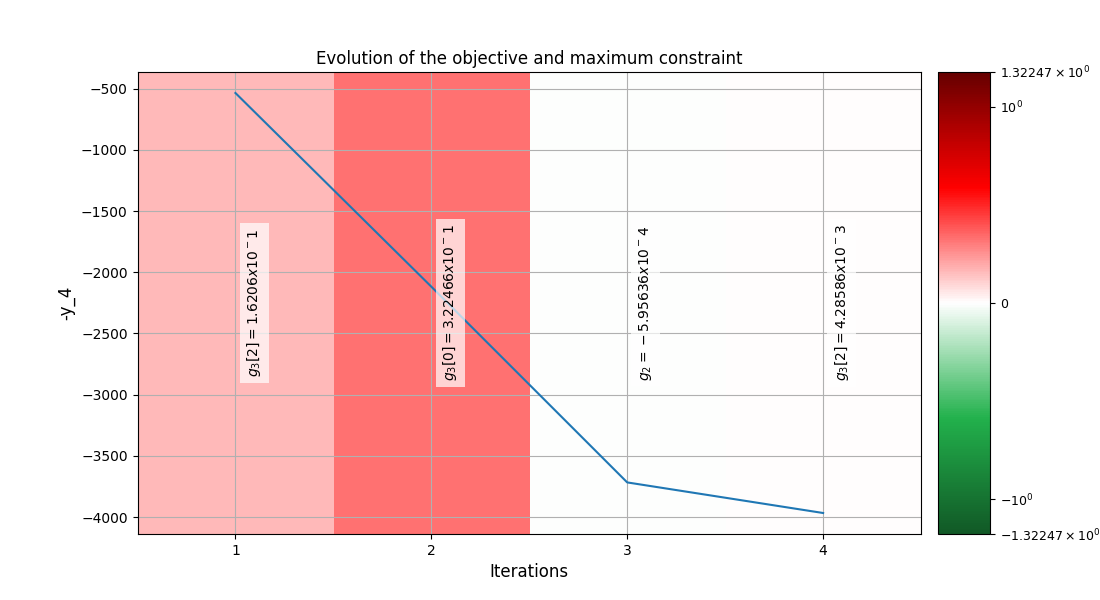
<gemseo.post.obj_constr_hist.ObjConstrHist object at 0x7f2d14f7c250>
Plot the constraints history¶
scenario.post_process(
"ConstraintsHistory",
constraint_names=["g_1", "g_2", "g_3"],
save=False,
show=True,
)
![Evolution of the constraints w.r.t. iterations, g_1[0] (inequality), g_1[1] (inequality), g_1[2] (inequality), g_1[3] (inequality), g_1[4] (inequality), g_1[5] (inequality), g_1[6] (inequality), g_2 (inequality), g_3[0] (inequality), g_3[1] (inequality), g_3[2] (inequality), g_3[3] (inequality)](../../_images/sphx_glr_plot_sobieski_mdf_example_009.png)
<gemseo.post.constraints_history.ConstraintsHistory object at 0x7f2d14e01820>
Plot the constraints history using a radar chart¶
scenario.post_process(
"RadarChart",
constraint_names=["g_1", "g_2", "g_3"],
save=False,
show=True,
)

<gemseo.post.radar_chart.RadarChart object at 0x7f2d14a8c250>
Plot the quadratic approximation of the objective¶
scenario.post_process("QuadApprox", function="-y_4", save=False, show=True)
<gemseo.post.quad_approx.QuadApprox object at 0x7f2d14931370>
Plot the functions using a SOM¶
scenario.post_process("SOM", save=False, show=True)
![Self Organizing Maps of the design space, -y_4, g_1[0], g_1[1], g_1[2], g_1[3], g_1[4], g_1[5], g_1[6], g_2, g_3[0], g_3[1], g_3[2], g_3[3]](../../_images/sphx_glr_plot_sobieski_mdf_example_013.png)
INFO - 13:54:44: Building Self Organizing Map from optimization history:
INFO - 13:54:44: Number of neurons in x direction = 4
INFO - 13:54:44: Number of neurons in y direction = 4
<gemseo.post.som.SOM object at 0x7f2d148b2610>
Plot the scatter matrix of variables of interest¶
scenario.post_process(
"ScatterPlotMatrix",
variable_names=["-y_4", "g_1"],
save=False,
show=True,
fig_size=(14, 14),
)

<gemseo.post.scatter_mat.ScatterPlotMatrix object at 0x7f2d13c86910>
Plot the variables using the parallel coordinates¶
scenario.post_process("ParallelCoordinates", save=False, show=True)
<gemseo.post.para_coord.ParallelCoordinates object at 0x7f2d13cc1130>
Plot the robustness of the solution¶
scenario.post_process("Robustness", save=True, show=True)
<gemseo.post.robustness.Robustness object at 0x7f2d12963670>
Plot the influence of the design variables¶
scenario.post_process("VariableInfluence", fig_size=(14, 14), save=False, show=True)
![Partial variation of the functions wrt design variables, 9 variables required to explain 99% of -y_4 variations, 5 variables required to explain 99% of g_1[0] variations, 5 variables required to explain 99% of g_1[1] variations, 5 variables required to explain 99% of g_1[2] variations, 5 variables required to explain 99% of g_1[3] variations, 5 variables required to explain 99% of g_1[4] variations, 4 variables required to explain 99% of g_1[5] variations, 4 variables required to explain 99% of g_1[6] variations, 1 variables required to explain 99% of g_2 variations, 7 variables required to explain 99% of g_3[0] variations, 7 variables required to explain 99% of g_3[1] variations, 3 variables required to explain 99% of g_3[2] variations, 3 variables required to explain 99% of g_3[3] variations](../../_images/sphx_glr_plot_sobieski_mdf_example_017.png)
INFO - 13:54:48: Output name; most influential variables to explain 0.99% of the output variation
INFO - 13:54:48: -y_4; x_1[1], x_2, x_3, x_shared[0], x_shared[1], x_shared[2], x_shared[3], x_shared[4], x_shared[5]
INFO - 13:54:48: g_1[0]; x_1[0], x_1[1], x_shared[0], x_shared[3], x_shared[5]
INFO - 13:54:48: g_1[1]; x_1[0], x_1[1], x_shared[0], x_shared[3], x_shared[5]
INFO - 13:54:48: g_1[2]; x_1[0], x_1[1], x_shared[0], x_shared[3], x_shared[5]
INFO - 13:54:48: g_1[3]; x_1[0], x_1[1], x_shared[0], x_shared[3], x_shared[5]
INFO - 13:54:48: g_1[4]; x_1[0], x_1[1], x_shared[0], x_shared[3], x_shared[5]
INFO - 13:54:49: g_1[5]; x_1[0], x_1[1], x_shared[3], x_shared[5]
INFO - 13:54:49: g_1[6]; x_1[0], x_1[1], x_shared[3], x_shared[5]
INFO - 13:54:49: g_2; x_shared[0]
INFO - 13:54:49: g_3[0]; x_2, x_3, x_shared[0], x_shared[1], x_shared[2], x_shared[4], x_shared[5]
INFO - 13:54:50: g_3[1]; x_2, x_3, x_shared[0], x_shared[1], x_shared[2], x_shared[4], x_shared[5]
INFO - 13:54:50: g_3[2]; x_3, x_shared[1], x_shared[2]
INFO - 13:54:50: g_3[3]; x_3, x_shared[1], x_shared[2]
<gemseo.post.variable_influence.VariableInfluence object at 0x7f2d13d56130>
Total running time of the script: (0 minutes 11.524 seconds)

